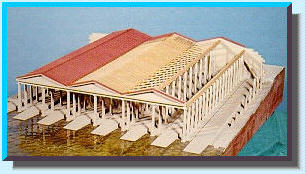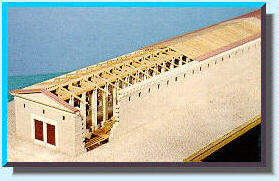An authentic section of the wall which goes through this actual site, has been included in the structure of the Naval Museum. The walls were built by Themistocles for the defence of Athens and Piraeus from land. A short time later Kimon and Pericles had them joined with the addition of the Long Walls.
Themistocles was one of the greatest political and military leaders in ancient Greece. He was involved in the early stages in the political life of the city of Athens and he joined the anti-Persian movement. He convinced the Athenians to move their naval base from Faliro to Piraeus which was a better site to facilitate a safe port. He also managed to convince the Athenians to invest the profits from the mines of Laurio (mines of Lead and Silver) in building the battle fleet. Themistocles was the leader of this Greek fleet of 400 vessels which defeated the Persian fleet of 1,200 vessels in the waters of the Bay of Salamis.
The Battle of Salamis was one of the greatest and most decisive martial conflicts in the world history. During this final confrontation between Greeks and Persians, which took place in the straits of Salamis on September 28th 480 B.C., the Greek fleet (of a total of 400 vessels of which 200 were Athenian) under the command of Themistocles, crushed the Persian fleet (1200 vessels of which 400 Phoenician) and brought to an end the Persian King Xerxes' dreams of world conquest. This big victory by the Greeks against the Persians was a historical milestone in the later development of Greece.


These NEOSOIKOI were roofed constructions in contact with the sea, in which triremes were sheltered when not on active service. Their floors were sloped and they would go right into the sea for part of their length, to facilitate the drawing-up of the vessel from the sea. The section of the floor ashore had an average length of 40 metres, and it was roofed with a sloping roof of tiles which were supported on pillars. Each hangar could shelter two triremes, one alongside the other. At the three arsenals of the city of Athens, Zia (now named Zea, or Passalimani), Mounihia (now named Microlimano), and the Cantharos (to the right when sailing into Piraeus harbour), there were in all 378 "Neosoikoi" which were able to shelter 756 triremes at a time.

Philo's "Skevotheke" named after Philo, the famous architect (IV century B.C.) who built it. It was an impressive structure for general storage of a miscellany of accessories of the fleet of the City of Athens such as, masts, yards sails, ropes oars, anchors, weapons, fittings, materials, etc. A unique inscription which was discovered nearby details the terms given to the building contractor which allowed archaeologists to reproduce the structure with great accuracy. Thus, among many other interesting details, we learn that the structure was 133 metres long, 18 metres wide and 10 metres high. The floor and the walls were made of marble, and the structure was separated inside by a double colonade of a central corridor with two side sections that were two-storeyed where all the materials were stored. It was located at the rear of the Zia Arsenal's "Neosoikoi" (roughly the site where Canaris Square, in Piraeus, is at present located).
The Hellenic Maritime Museum
Akti Themistokleous
Freattida
185 37 Piraeus
Hellas